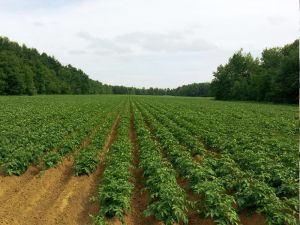Potato

The challenge for potato cultivation is to to reduce labour time as much as possible in order to production costs while remaining attractive attractive to large growers.
Preparing the soil
Potatoes are grown after a long period of tarpaulin to ensure the soil is clean and loose.
It's best to grow on straw, although it is possible to grow on tarpaulin or compost/biofuel. on tarpaulin or compost/shredded soil, particularly for early early crops. Straw is spread after planting, to a good thickness a good thickness, at least 40 to 50 cm.
Planting
Tubers for seed are stored in a chamber. room. For early crops, pre-sprouting 1 to 2 months before planting is recommended as follows as follows : in a well-lit room, with 80-90% humidity and a room temperature of 15-20°C. The sprouts should not wither but remain stocky. Place the plants on the ground at a minimum temperature of 10°C, by hand or with a planter.
The density of planting depends on the production objective.
early potatoes, to encourage lots of small potatoes.
small potatoes. Conversely, for ware potatoes
Conversely, for ware potatoes, favour lower densities to increase the size.
Spread about 40-50 cm of straw over the potatoes on the ground.
potatoes on the ground. Too much straw is better
than too little. Potatoes have large reserves and can
can break through thick mulch. A second layer of mulch will prevent
greening.
Tip : To obtain small tubers, prefer large mother tubers with several sprouts, while to obtain large tubers, small mother tubers with fewer sprouts are ideal.
Growing follow-up
Once the tubers have been planted and covered, if the straw is thick enough, there's not much left to do.
Keep an eye on irrigation at the start of the crop, as well as during dry spells, and look out for any pest problems.
When the crop reaches a height of 5 to 10 cm, mulch by hand between rows to smother and prevent the germination of new weeds.
Irrigation
With its relatively shallow root system, the potato is sensitive to water stress. The water requirements vary according to variety, but are about 20mm/week. Irrigation may be required for early crops grown under cover. Thick mulching has the advantage of greatly reducing irrigation requirements. The tuberisation phase begins just before flowering and continues and continues afterwards. Irrigation needs are greatest during during tuber formation, as dry spells at this stage will reduce the yield.
Harvest
Early crops are harvested when they are immature. when half the foliage has turned yellow. yellow in colour. Harvesting on straw, which is difficult difficult to mechanise is often done by hand. This can be time-consuming and tedious, which is why some growers only early potatoes with higher added value and on smaller on smaller areas. Potatoes turn turn green in the light, so store them in a cool, dark place.
Storage
For short-term storage, a cool room or cellar is sufficient. cellar is sufficient, but for storage of 6 to 9 months, the ideal conditions are a temperature of 4 to 7°C and 90-95% humidity. humidity. Storage in a room can be in sand, but is often sand, but is often stored in paloxes or crates. Sort potatoes during storage to make them easier to sell and and reduces the risk of rotting.
Pests and diseases
- The main problem with potatoes is the Colorado potato beetle, particularly on young plants. Keep an eye out for them and contain the damage by picking up the beetles. Small manual machines are available to sweep the plants and pick up large quantities of CPB quickly.
- The other main problem is downy mildew. If the plants are affected, destroy the leaves when the mildew starts to move down the stem. The idea is to destroy the foliage before the mildew moves down into the tubers and damages the tubers. Yields will be lower but this avoids losing the whole crop.
Possible ITK variations
It is possible to broadcast the tubers if a large area is planted. a large area, but yields will be lower. Leave the green and damaged potatoes on the spot, then mulch in the autumn, the crop is ready for next year. next year. If necessary, replant in the spring.
Photo gallery
Sources
- This page is based on the guide Introduction au maraîchage sol vivant from MSV Normandie.
